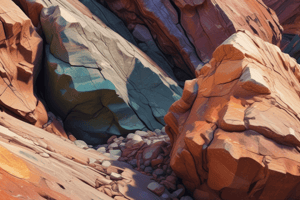Podcast
Questions and Answers
What type of rock is Gneiss?
What type of rock is Gneiss?
- Foliated (correct)
- Nonfoliated
What is the parent rock of Anthracite Coal?
What is the parent rock of Anthracite Coal?
Peat, lignite, bituminous coal
Which of the following characteristics describe Slate?
Which of the following characteristics describe Slate?
- Alternating lighter and darker bands
- Dull luster and slaty cleavage (correct)
- Glassy and conchoidal fracture
What type of rock is Schist?
What type of rock is Schist?
What trait distinguishes Phyllite?
What trait distinguishes Phyllite?
What type of rock is Quartzite?
What type of rock is Quartzite?
List one parent rock of Serpentine.
List one parent rock of Serpentine.
What type of rock is Marble?
What type of rock is Marble?
Which mineral is primarily found in Marble?
Which mineral is primarily found in Marble?
Flashcards are hidden until you start studying
Study Notes
Gneiss
- Foliated metamorphic rock with medium to coarse grain size.
- Characterized by alternating lighter and darker bands that are sub-parallel and discontinuous.
- Formed from parent rocks such as mudstone, shale, slate, phyllite, schist, granite, and diorite.
Anthracite Coal
- Nonfoliated type of metamorphic rock with a glassy appearance.
- Exhibits conchoidal fracture.
- Derived from peat, lignite, and bituminous coal.
Slate
- Foliated metamorphic rock known for its dull luster and slaty cleavage.
- Typically originates from mudstone or shale.
Schist
- Foliated rock with a fine to medium grain that feels smooth to the touch.
- Contains visible crystals of mica minerals (biotite, chlorite, muscovite), quartz, and plagioclase.
- Parent rock includes mudstone, shale, slate, and phyllite.
Phyllite
- Foliated rock featuring breaks along wrinkled or wavy foliation.
- Formed from mudstone, shale, or slate.
Quartzite
- Nonfoliated metamorphic rock with closely interlocked quartz grains.
- Light in color, but may appear in various shades like gray, purple, brown, and yellow.
- Derived from sandstone and quartz.
Serpentine
- Nonfoliated rock with a dull to glossy finish.
- Formed from basalt, gabbro, and ultramafic igneous rocks.
Marble
- Nonfoliated metamorphic rock with a medium-grained, granular texture that feels gritty.
- Contains interlocking calcite crystals visible to the naked eye and is reactive with HCL.
- Derived from limestone, often found in colors like pink and white.
- Commonly used as a building stone and in products like toothpaste, paint, and paper.
Studying That Suits You
Use AI to generate personalized quizzes and flashcards to suit your learning preferences.




